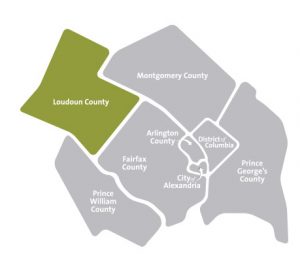Although health indicators assist in understanding the health of a geographically defined population, they do not tell the whole story. For example, a baby born in census tract 6105.01 in Leesburg can be expected to live 7 fewer years than a baby born 7 miles away, in nearby Countryside (census tract 6110.03). Within these seven miles, median annual income drops from $101,713 in Countryside to $73,431 in Leesburg; the percentage of adults with at least a bachelor’s degree drops from 61.5% to 38.3%; and the percentage of black and Hispanic residents jumps from 5.5% and 5.9% in Countryside, to 14.1% and 18% in Leesburg, respectively. Other measures of health tell similar stories of inequity when broken down by race: black residents have an infant mortality rate 3 times greater than that of white residents. Amongst Medicare beneficiaries 65+, black residents have an increased rate of hospitalization due to high blood pressure, compared to their white or Hispanic neighbors; while Hispanic residents have a much lower rate of hospitalization due to heart disease.
Within Loudoun County, there are significant disparities in health amongst people of different races, ethnicities, and incomes. These differences can be partially attributed to social determinants of health, which, according to the World Health Organization, are the conditions in which people are born, grow, work, live, and age.
Although Loudoun County has a number of health resources, accessing health services proves challenging for some county residents. There is one primary care physician for every 1,350 residents of Loudoun County. Although there is no widely accepted optimal rate of physicians to total population, Loudoun is ranked in the top 90% of the United States for this metric. Inova Loudoun Hospital, a part of the not-for-profit Inova Healthcare System, is a 183-bed acute care community hospital located in Leesburg. StoneSprings Hospital Center, part of the HCA Virginia Health System, is a 124-bed center located in Dulles. Additionally, there are many urgent care centers located within the county, and Loudoun County’s local public health system provides a number of immunizations and testing for tuberculosis and sexually transmitted infections for some residents. However, the majority of these resources are located in the eastern portion of the county, between Leesburg and Sterling. For some residents in the western portion of the county, this means traveling more than 20 miles one-way to access services in Leesburg.
In addition to geography, cost may be a barrier for the 9% of Loudoun residents who are uninsured. Although this rate is lower than Virginia’s average of 14%, it remains higher than the averages of neighboring West Virginia (8%), and Maryland (7%), where Medicaid was expanded. Those without insurance or resources to pay for care rely on safety-net health care clinics for primary health care services. Inova Juniper has an HIV/AIDs clinic located in Leesburg. There is one Federally Qualified Health Center (FQHC), HealthWorks for Northern Virginia, and one free clinic, Loudoun Free Clinic, located within Loudoun County. Additionally, there are two other FQHCs in nearby counties that serve Loudoun residents.
Although Loudoun County is one of the healthiest in the country, inequities amongst its residents persist. Making Loudoun County a healthier place for all to live requires not only expanding wellness initiatives and access to quality healthcare, but also addressing the economic and social wellbeing of its citizens.






